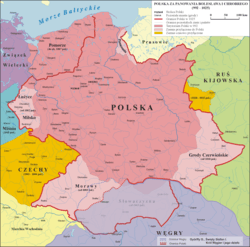Cherven Cities
The Cherven Cities or Cherven Grods (Polish: Grody Czerwieńskie, Ukrainian: Червенські городи), often literally translated as Red Cities | Red Forts | Red Boroughs (most accurate probably), was a point of dispute between the Kingdom of Poland and Kievan Rus' at the turn of 10th and 11th centuries, with both sides claiming their rights to the land.

Etymology
Originally, the name "Cherven Cities" probably identified a territory between the Bug and Wieprz rivers. Its name is derived from Cherven (cf. Proto-Slavic *čьrvenъ "red"), a gord that existed there, possibly on the site of the present village of Czermno.[1]
It also has a geographical sense. The first mention of the "Cherven cities" is given by the Primary Chronicle (in 981, 992), when Volodymyr the Great captured them from the Poles.[2] Thus, it was the Ruthenians who named these lands "Cherven Cities" ("Red Citites"). It is important, because in Kyivan Rus' red colour symbolized west side of the world. Consequently, "Cherven Cities" ("Red Cities") could also mean the lands and cities that are located in the west of Kyivan Rus' - "West Cities".
History

In early medieval times, Slavic tribes, the Vyatichi and Radimichs, settled in this area. Nestor (c. 1056 – c. 1114), the reputed author of the Primary Chronicle, refers to the Vyatichi and Radimichs as Lachy (Lendians important Lechitic group).[3] From the mid-950s onward, the Lendians were politically anchored in the Bohemian sphere of influence. Cosmas of Prague (c. 1045 – 1125) relates that the Přemyslid rulers of Bohemia controlled the land of Kraków until 999.[4] In support of Cosmas, the foundation charter of the Archdiocese of Prague (1086) traces the eastern border of the archdiocese, as established in 973, along the Bug and Styr (or Stryi) rivers.[5] Abraham ben Jacob, who travelled in Eastern Europe in 965, remarks that Boleslaus II of Bohemia ruled the country "stretching from the city of Prague to the city of Kraków".[6]
In the 970s, Mieszko I of Poland took over the region: the Primary Chronicle infers this when reporting that Volodymyr the Great conquered the Red Cities from the Poles in 981. Volodymyr the Great of Kievan Rus' took over the Red Ruthenian strongholds in his military campaign on the border with the land of Lendians. Nestor reports in his chronicle that: "Volodymyr marched upon the Lyakhs (Poles) and took their cities: Peremyshl (modern Przemyśl), Cherven (modern Czermno), and other towns".[3][7][8]
In 1018, Poland re-took the area under Bolesław I the Brave,[9] in 1031 it fell again to Rus'. The Rus'ian expedition against Poland (1030–1031) had as its object not only the recovery of territories previously lost (1018); it also delivered a powerful blow against the Polish Metropolis of Slavonic rite.[10] In 1031, Harald and his men reached the land of the Kievan Rus, where they served the armies of Yaroslav I the Wise, the Grand Prince of the Rus, whose wife Ingigerd was a distant relative of Harald. In the spring 1031, where he became chief of Yaroslav's bodyguard jointly with Eilifr, son of that Rognvaldr who had originally come to Novgorod with Ingigerd. Harald served a military apprenticeship, fighting in the Polish campaign of 1031, and against the Læsir (Lendians).[11] The gord of Sutiejsk was most likely founded in 1034 - 1039 by Grand Prince Yaroslav the Wise, who built the fortified settlement to guard the border with Poland.
See also
- Czerwień
- Lędzianie
- Red Ruthenia
- Sutiejsk
References
- (in Ukrainian) Въ лЂто 6478 [970] - 6494 [986]. Лаврентіївський літопис
- Samuel Hazzard Cross and Olgerd P. Sherbowitz-Wetzor. The Russian Primary Chronicle. Laurentian Text (PDF). THE MEDIAEVAL ACADEMY OF AMERICA. p. 95.
- Russian text of the chronicle of Nestor in PDF
- Die Chronik der Böhmen des Cosmas von Prag. Berlin, 1923 (MGH SS rer. Germ. NS, 2). I, 33–34. Page 60.
- The entire vicinity of Krakow was to be administered from Prague: "…ad orientem hos fluvios habet terminos: Bug scilicet et Ztir cum Cracouua civitate provintiaque cui Uuag nomen est cum omnibus regionibus ad predictam urbem pertinentibus, que Cracouua est".
- Relacja Ibrahima Ibn Ja'kuba z podróży do krajów słowiańskich w przekazie Al-Bekriego. Kraków, 1946 (MPH NS. 1). Page 50.
- The later Halych-Volhynian Chronicle, when describing King Danylo's expedition to Kalisz in 1227, remarks that "no other prince had entered so far into Poland, apart from Vladimir the Great, who had christened that land".
- Pucek, Zdzisław (1992-10-03). "Book review. K. Kowalski, B. Rzebik-Kowalska, 1991: Mammals of Algeria. Wrocław-Warszawa-Kraków, Ossolineum-Zakład Narodowy im. Ossolińskich - Wydawnictwo Polskiej Akademii Nauk. 370 pp". Acta Theriologica. 37: 140. doi:10.4098/at.arch.92-14. ISSN 0001-7051.
- A. Buko. "The archaeology of early medieval Poland". Brill. 2008. p. 307
- Paszkiewicz. The making of the Russian nation, 1977 p. 104
- In Slavic loanwords ja was replaced with æ, e.g., læsir = Ljach, plural Ljasi, meaning 'Polack/Polacks', [in:] s. Axel Olrik i Festskrift til Vilh. Thomsen, 126 f.; [in:] trans. Arkiv för nordisk filologi: t. 19-20. page 280